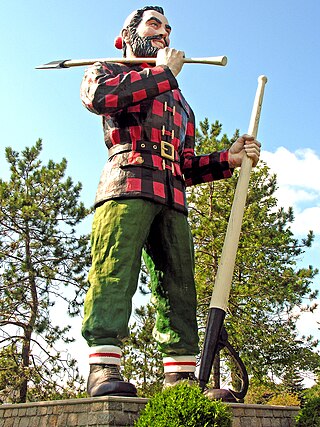
Paul Bunyan is a giant lumberjack and folk hero in American and Canadian folklore. His tall tales revolve around his superhuman labors, and he is customarily accompanied by Babe the Blue Ox, his pet and working animal. The character originated in the oral tradition of North American loggers, and was later popularized by freelance writer William B. Laughead (1882–1958) in a 1916 promotional pamphlet for the Red River Lumber Company. He has been the subject of various literary compositions, musical pieces, commercial works, and theatrical productions. His likeness is displayed in a number of oversized statues across North America.
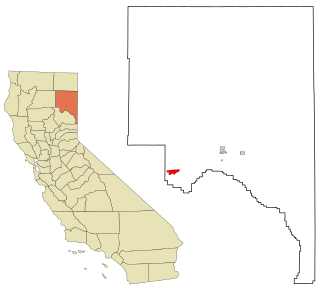
Westwood is a census-designated place (CDP) in Lassen County, California, United States. Westwood is located 20 miles (32 km) west-southwest of Susanville, at an elevation of 5,128 feet. Its population is 1,541 as of the 2020 census, down from 1,647 from the 2010 census..

Bemidji is a city and the county seat of Beltrami County, in northern Minnesota, United States. The population was 14,574 at the 2020 census. According to 2022 census estimates, the city is estimated to have a population of 15,946, making it the largest commercial center between Grand Forks, North Dakota and Duluth.

Rib Mountain, also known as Rib Hill, is a glacially-eroded monadnock in central Wisconsin, located in the Town of Rib Mountain in Marathon County. Composed of quartzite covered with a softer syenite sheath, it was intruded about 1.5 billion years ago.

Lake Bemidji is a small glacially-formed lake, approximately 11 square miles in area, in northern Minnesota in the United States. Located less than 50 miles (80 km) downstream from the source of the Mississippi River, it both receives and is drained by the Mississippi, and is the northernmost point on the river.
Kenton is a neighborhood in the north section of Portland, Oregon, United States. The neighborhood was originally a company town founded in 1911 for the Swift Meat Packing Company.
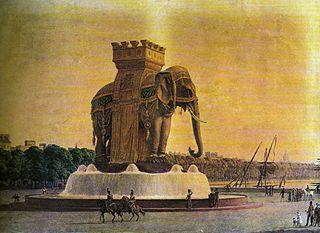
Novelty architecture, also called programmatic architecture or mimetic architecture, is a type of architecture in which buildings and other structures are given unusual shapes for purposes such as advertising or to copy other famous buildings without any intention of being authentic. Their size and novelty means that they often serve as landmarks. They are distinct from architectural follies, in that novelty architecture is essentially usable buildings in eccentric form whereas follies are non-usable, purely ornamental buildings also often in eccentric form.
Paul Bunyan is a mythical lumberjack.

Trees of Mystery is a park and tourist attraction along U.S. Route 101 near the coastal town of Klamath, California. It features interpretive trails through Giant Redwoods and a number of unusual tree formations, many of which can be seen from its Trail of Mysterious Trees. Its Trail of Tall Tales displays some 50 chainsaw sculptures and carvings illustrating stories of legendary logger Paul Bunyan and his crew.

The Paul Bunyan State Trail is a multi-use recreational rail trail in north-central Minnesota, United States, running between the cities of Baxter/Brainerd and Bemidji. It is named after the giant lumberjack Paul Bunyan of American folklore.
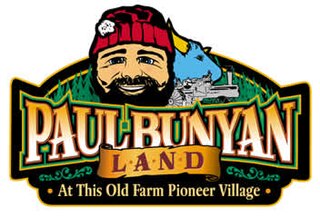
Paul Bunyan Land is an amusement park in Brainerd, Minnesota, founded in 1950, which is today located on This Old Farm. Its trademark is the 26-foot-tall (7.9 m) animated and talking statue of Paul Bunyan, weighing 5,000 pounds. As guests enter, Paul welcomes them by name.
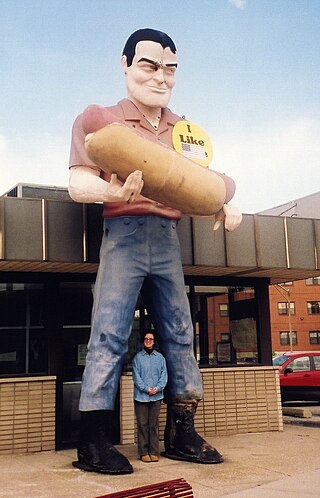
Muffler men are large moulded fiberglass sculptures that are placed as advertising icons, roadside attractions, or for decorative purposes, predominantly in the United States. Standing approximately 18–25 ft (5.5–7.6 m) tall, the first figure was a Paul Bunyan character designed to hold an axe. Derivatives of that figure were widely used to hold full-sized car mufflers, tires, or other items promoting various roadside businesses.
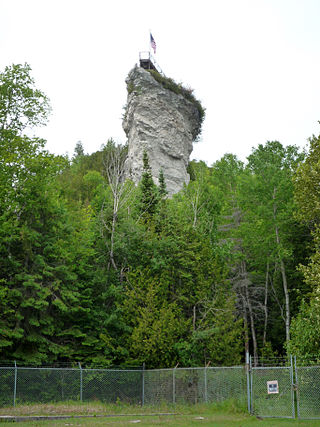
Castle Rock is a geological limestone stack and tourist attraction located 3 miles (5 km) north of St. Ignace, Michigan on Interstate 75 in Michigan's Upper Peninsula.
There are a number of statues of Paul Bunyan on display in the United States.

Paul Bunyan is a 1958 American animated musical short film produced by Walt Disney Productions. The short was based on the North American folk hero and lumberjack Paul Bunyan and was inspired after meeting with Les Kangas of Paul Bunyan Productions, who gave Disney the idea for the film. The film was directed by Les Clark, a member of Disney's Nine Old Men of core animators. Thurl Ravenscroft starred as the voice of Paul Bunyan. Supporting animators on the project included Lee Hartman.
Since the folkloric hero Paul Bunyan's first major appearance in print, the character has been utilized to promote a variety of products, locations, and services. The giant lumberjack's mass appeal has led him to become a recurring figure in entertainment and marketing, appearing in various incarnations throughout popular culture.

Paul Bunyan Statue is a 31-foot-tall (9.4 m) concrete and metal sculpture of mythical logger Paul Bunyan in the Kenton neighborhood of Portland, Oregon, United States. It was built in 1959 to commemorate the centennial of Oregon's statehood during the Centennial Exposition and International Trade Fair, which was held in the Kenton area.

The Bemidji Blue Ox Marathon is a race in Bemidji, Minnesota, first run in 2013. The race runs around a lake, along a state trail and through a state park. It takes place in October, when many of the forest surroundings are bright with color.
















